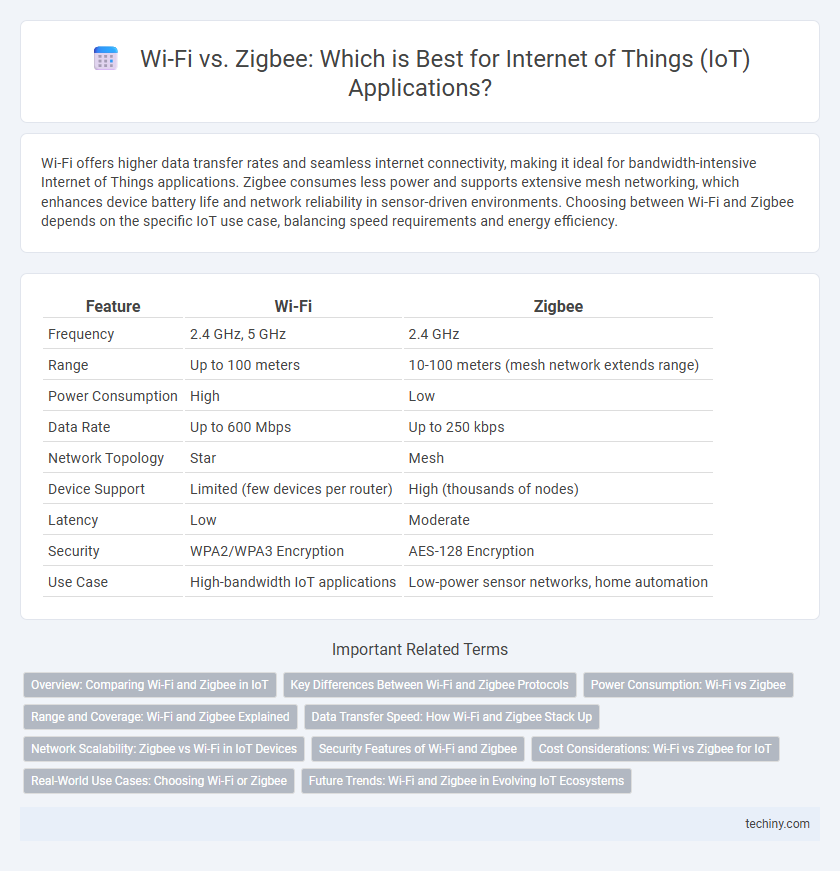Wi-Fi offers higher data transfer rates and seamless internet connectivity, making it ideal for bandwidth-intensive Internet of Things applications. Zigbee consumes less power and supports extensive mesh networking, which enhances device battery life and network reliability in sensor-driven environments. Choosing between Wi-Fi and Zigbee depends on the specific IoT use case, balancing speed requirements and energy efficiency.
Table of Comparison
| Feature | Wi-Fi | Zigbee |
|---|---|---|
| Frequency | 2.4 GHz, 5 GHz | 2.4 GHz |
| Range | Up to 100 meters | 10-100 meters (mesh network extends range) |
| Power Consumption | High | Low |
| Data Rate | Up to 600 Mbps | Up to 250 kbps |
| Network Topology | Star | Mesh |
| Device Support | Limited (few devices per router) | High (thousands of nodes) |
| Latency | Low | Moderate |
| Security | WPA2/WPA3 Encryption | AES-128 Encryption |
| Use Case | High-bandwidth IoT applications | Low-power sensor networks, home automation |
Overview: Comparing Wi-Fi and Zigbee in IoT
Wi-Fi delivers high-speed data transfer and broad coverage ideal for bandwidth-intensive IoT applications, while Zigbee offers low power consumption and mesh networking suited for battery-operated devices in smart homes. Zigbee operates on the IEEE 802.15.4 protocol with a range of up to 100 meters and supports thousands of nodes, optimizing scalability for extensive sensor networks. Wi-Fi supports greater data throughput, typically around 54 Mbps to several Gbps depending on the standard, but at higher power costs, making Zigbee a preferred choice for energy-efficient, low-data-rate IoT deployments.
Key Differences Between Wi-Fi and Zigbee Protocols
Wi-Fi operates on higher bandwidths and is suitable for data-intensive IoT applications requiring fast internet connectivity, while Zigbee is designed for low-power, low-data rate communication ideal for battery-powered sensors and home automation devices. Zigbee uses a mesh topology to extend network range and improve reliability, whereas Wi-Fi typically relies on a star topology centered around a router. Security protocols in Wi-Fi (WPA3) offer robust encryption compared to Zigbee's AES-128, reflecting different priorities in IoT use cases.
Power Consumption: Wi-Fi vs Zigbee
Zigbee technology significantly outperforms Wi-Fi in power consumption, making it ideal for battery-powered Internet of Things (IoT) devices requiring long-term operation. Wi-Fi modules typically consume 10 to 100 times more power than Zigbee, resulting in shorter device lifespans without frequent recharging. This energy efficiency advantage enables Zigbee networks to support thousands of sensors and actuators with minimal maintenance.
Range and Coverage: Wi-Fi and Zigbee Explained
Wi-Fi typically offers a range of up to 150 feet indoors and 300 feet outdoors, making it suitable for applications requiring high data throughput over medium distances. Zigbee operates within a shorter range of approximately 10 to 100 meters but excels in forming mesh networks that extend overall coverage efficiently in smart home environments. Zigbee's low power consumption and network scalability make it ideal for IoT devices needing long battery life and reliable connectivity over extended areas.
Data Transfer Speed: How Wi-Fi and Zigbee Stack Up
Wi-Fi offers significantly higher data transfer speeds, typically ranging from 54 Mbps to several Gbps, making it ideal for bandwidth-intensive IoT applications like video streaming and large data uploads. Zigbee, designed for low-power, low-data-rate devices, operates at speeds up to 250 Kbps, prioritizing energy efficiency and long battery life over speed. The choice between Wi-Fi and Zigbee depends on specific IoT needs, balancing data throughput with power consumption and network complexity.
Network Scalability: Zigbee vs Wi-Fi in IoT Devices
Zigbee excels in network scalability for IoT devices by supporting large mesh networks with thousands of nodes, which enables extensive device interconnectivity and reliable data transmission across wide areas. Wi-Fi networks typically handle fewer connected devices due to bandwidth constraints and higher power consumption, limiting scalability in dense IoT environments. Zigbee's low power consumption combined with its ability to form self-healing mesh networks makes it ideal for scalable IoT deployments where numerous sensors and actuators must communicate efficiently.
Security Features of Wi-Fi and Zigbee
Wi-Fi employs advanced WPA3 encryption, providing robust protection against unauthorized access and eavesdropping, while Zigbee utilizes AES-128 encryption tailored for low-power IoT devices, ensuring secure data transmission within mesh networks. Wi-Fi's security protocols support frequent firmware updates and complex authentication methods, enhancing resilience against evolving cyber threats. Zigbee offers inherent security features like network key management and device authentication optimized for constrained environments, balancing energy efficiency with strong protection.
Cost Considerations: Wi-Fi vs Zigbee for IoT
Zigbee offers a cost-effective solution for IoT applications due to its low power consumption and simpler hardware requirements, significantly reducing operational and maintenance expenses. Wi-Fi modules tend to be more expensive and consume more power, leading to higher costs in large-scale deployments where energy efficiency is critical. Selecting Zigbee can optimize budget allocation for IoT networks with numerous devices requiring extended battery life and minimal infrastructure investment.
Real-World Use Cases: Choosing Wi-Fi or Zigbee
Wi-Fi excels in smart home setups requiring high data throughput and seamless internet connectivity, such as streaming security cameras and smart TVs. Zigbee is ideal for low-power, low-data devices like sensors and smart lighting systems, offering extended battery life and mesh networking for broader coverage. Selecting between Wi-Fi and Zigbee depends on device power constraints, data requirements, and network scale within IoT ecosystems.
Future Trends: Wi-Fi and Zigbee in Evolving IoT Ecosystems
Wi-Fi and Zigbee are poised to transform evolving IoT ecosystems through enhanced connectivity and energy efficiency. Wi-Fi 6 and upcoming Wi-Fi 7 standards promise higher data rates and lower latency, optimizing smart home and industrial IoT deployments. Zigbee continues to advance with mesh networking improvements and increased device interoperability, supporting scalable, low-power IoT applications critical for smart cities and agriculture.
Wi-Fi vs Zigbee Infographic

 techiny.com
techiny.com